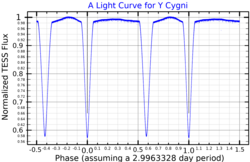Y Cygni
Y Cygni is an eclipsing and double-lined spectroscopic binary star system in the constellation of Cygnus. It is located about 4,900 light-years from Earth. The system was one of the first binaries with a convincing detection of the apsidal precession.[4]
The two stars, being O-type main-sequence stars, orbit each other with a period of nearly 3 days.[4]
Observation history
[edit]The early type of Y Cyg made it a popular target for astronomers in the past, and spectroscopic orbits have been historically computed numerous times.[5] The first of these studies was published in 1920 by John Stanley Plaskett.[6] Extensive spectroscopic studies of Y Cyg were carried out as early as 1930.[7] Several follow-ups to these have been published in 1959,[8] 1971,[9][10] and 1980.[11] The latter of these contained an estimate of the period of apsidal precession.
References
[edit]- ^ "MAST: Barbara A. Mikulski Archive for Space Telescopes". Space Telescope Science Institute. Retrieved 8 December 2021.
- ^ a b c d e Vallenari, A.; et al. (Gaia collaboration) (2023). "Gaia Data Release 3. Summary of the content and survey properties". Astronomy and Astrophysics. 674: A1. arXiv:2208.00211. Bibcode:2023A&A...674A...1G. doi:10.1051/0004-6361/202243940. S2CID 244398875. Gaia DR3 record for this source at VizieR.
- ^ a b Samus, N. N.; Durlevich, O. V.; et al. (2009). "VizieR Online Data Catalog: General Catalogue of Variable Stars (Samus+ 2007-2013)". VizieR On-line Data Catalog: B/GCVS. Originally Published in: 2009yCat....102025S. 1: B/gcvs. Bibcode:2009yCat....102025S.
- ^ a b c d e f g h i j k l m n o Harmanec, P.; Holmgren, D. E.; Wolf, M.; Božić, H.; Guinan, E. F.; Kang, Y. W.; Mayer, P.; McCook, G. P.; Nemravová, J.; Yang, S.; Šlechta, M.; Ruždjak, D.; Sudar, D.; Svoboda, P. (March 2014). "Revised physical elements of the astrophysically important O9.5+O9.5V eclipsing binary system Y Cygni". Astronomy and Astrophysics. 563: A120. arXiv:1403.0721. Bibcode:2014A&A...563A.120H. doi:10.1051/0004-6361/201323230. ISSN 0004-6361. S2CID 118651473.
- ^ Hill, G.; Holmgren, D. E. (May 1995). "Studies of early-type variable stars. IX. Y Cygni". Astronomy and Astrophysics. 297: 127–134. Bibcode:1995A&A...297..127H.
- ^ Jones, Harold Spencer (1 November 1942). "John Stanley Plaskett, 1865-1941". The Royal Society. 4 (11): 67–82. doi:10.1098/rsbm.1942.0007.
- ^ Redman, R. O. (August 1930). "Y Cygni". Publications of the Astronomical Society of the Pacific. 42: 250. Bibcode:1930PASP...42..250R. doi:10.1086/124047. S2CID 250785748.
- ^ Struve, O.; Sahade, J.; Zabergs, V. (January 1959). "Y Cygni". Astrophysical Journal. 129: 59. Bibcode:1959ApJ...129...59S. doi:10.1086/146595.
- ^ Vitrichenko, E. A. (1971). "The improvement of the Spectroscopic orbit of Y Cyg". Società Astronomia Italiana. 43: 71. Bibcode:1972MmSAI..43...71V.
- ^ Vitrichenko, E. A. (1971). "The improvement of the Spectroscopic orbit of Y Cyg". Izv. Krym. Astrofiz. Obs. 43: 71–75. Bibcode:1971IzKry..43...71V.
- ^ Gimenez, A.; Costa, V. (December 1980). "Y CYG : photometry and apsidal motion". Publications of the Astronomical Society of the Pacific. 92: 782–784. Bibcode:1980PASP...92..782G. doi:10.1086/130747. S2CID 120757652.

